The Intel Broadwell Review Part 2: Overclocking, IPC and Generational Analysis
by Ian Cutress on August 3, 2015 8:00 AM ESTGenerational Tests: Office and Web Benchmarks
For this review, as mentioned on the front page, we retested some of the older CPUs under our new methodology. We did this testing at stock frequency as well as the IPC testing to see the ultimate real world result when you add in HyperThreading and frequency into the mix. If you recall back in our Devil’s Canyon i7-4790K review, the new high 4.4 GHz frequency of the i7-4790K was a tough one to beat for the newer architecture purely because any IPC gains are nullified by the older processor having a lot more frequency. With the Broadwell based i7-5775C being at 3.7 GHz and only 65W, this is a tough task. But what about if you are still running the Sandy Bridge based i7-2600K?
Some users will notice that in our benchmark database Bench, we keep data on the CPUs we’ve tested back over a decade and the benchmarks we were running back then. For a few of these benchmarks, such as Cinebench R10, we do actually run these on the new CPUs as well, although for the sake of brevity and relevance we tend not to put this data in the review. Well here are a few of those numbers too.
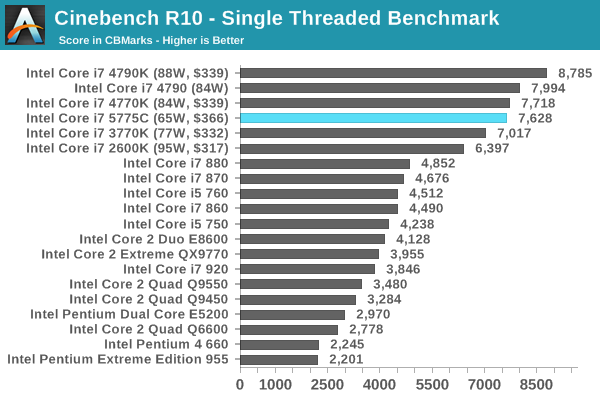
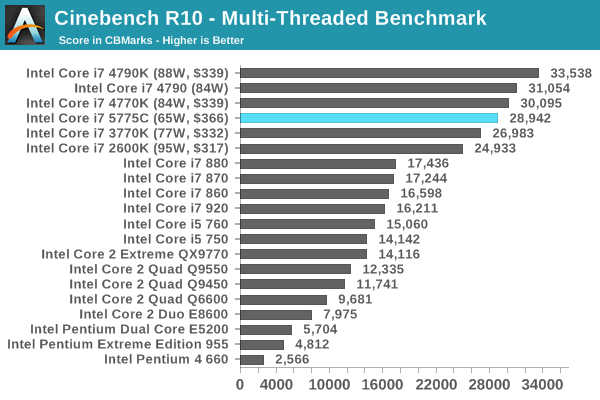


With some of these benchmarks, due to applications using new instruction sets, having the newer processors with the new instructions can make a lot of difference. Even in Cinebench R10, moving from the Core 2 Quad Q9550 to a Broadwell can get a 2.5x speed-up in this old software.
For the rest of our CPU benchmarks, here is what the landscape looks like with the most recent architectures. All of our benchmark results can also be found in our benchmark engine, Bench.
Office Performance
The dynamics of CPU Turbo modes, both Intel and AMD, can cause concern during environments with a variable threaded workload. There is also an added issue of the motherboard remaining consistent, depending on how the motherboard manufacturer wants to add in their own boosting technologies over the ones that Intel would prefer they used. In order to remain consistent, we implement an OS-level unique high performance mode on all the CPUs we test which should override any motherboard manufacturer performance mode.
Dolphin Benchmark: link
Many emulators are often bound by single thread CPU performance, and general reports tended to suggest that Haswell provided a significant boost to emulator performance. This benchmark runs a Wii program that raytraces a complex 3D scene inside the Dolphin Wii emulator. Performance on this benchmark is a good proxy of the speed of Dolphin CPU emulation, which is an intensive single core task using most aspects of a CPU. Results are given in minutes, where the Wii itself scores 17.53 minutes.

WinRAR 5.0.1: link
Our WinRAR test from 2013 is updated to the latest version of WinRAR at the start of 2014. We compress a set of 2867 files across 320 folders totaling 1.52 GB in size – 95% of these files are small typical website files, and the rest (90% of the size) are small 30 second 720p videos.
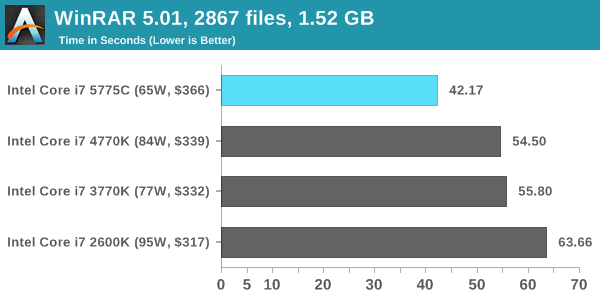
3D Particle Movement
3DPM is a self-penned benchmark, taking basic 3D movement algorithms used in Brownian Motion simulations and testing them for speed. High floating point performance, MHz and IPC wins in the single thread version, whereas the multithread version has to handle the threads and loves more cores.
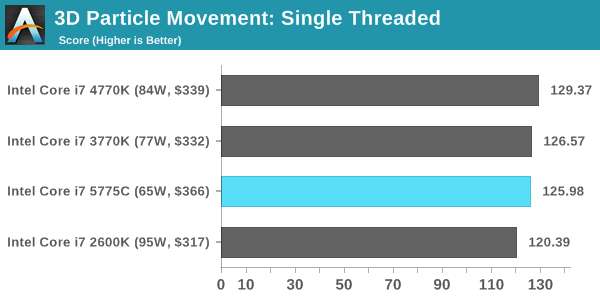
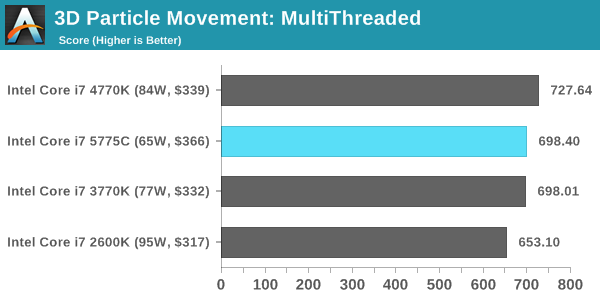
FastStone Image Viewer 4.9
FastStone is the program I use to perform quick or bulk actions on images, such as resizing, adjusting for color and cropping. In our test we take a series of 170 images in various sizes and formats and convert them all into 640x480 .gif files, maintaining the aspect ratio. FastStone does not use multithreading for this test, and results are given in seconds.
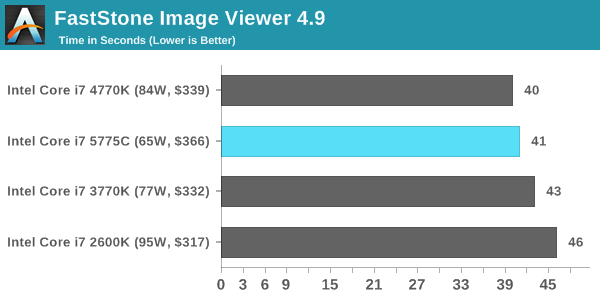
Web Benchmarks
On the lower end processors, general usability is a big factor of experience, especially as we move into the HTML5 era of web browsing. For our web benchmarks, we take four well known tests with Chrome 35 as a consistent browser.
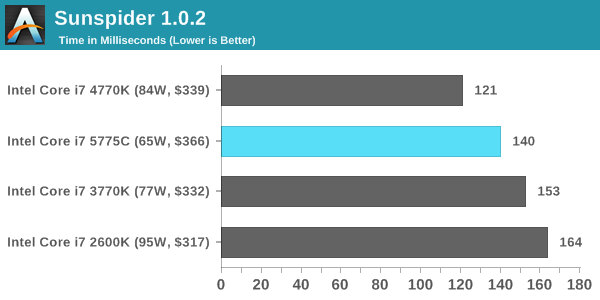
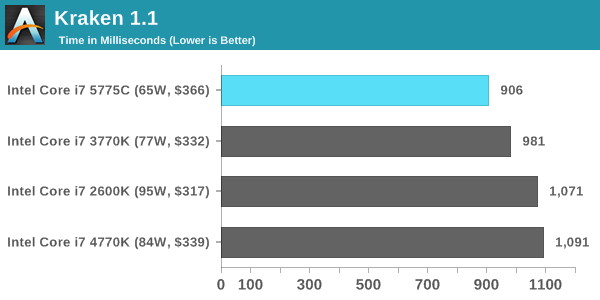
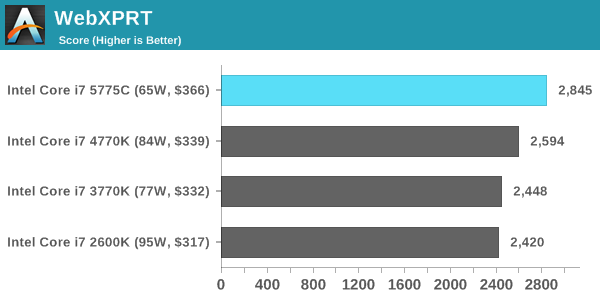
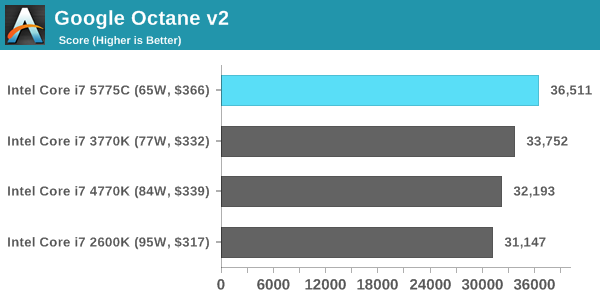










121 Comments
View All Comments
plonk420 - Wednesday, August 12, 2015 - link
you "blame" AMD?a fuckup warrants "blame." you can't really "blame" someone or some company for not being smart enough to outwit/outperform the competition.
david_tocker - Tuesday, August 4, 2015 - link
I recently upgraded my i7-920 to a Xeon x5670 in the same board. Less power, more performance, same motherboard. Has USB3 - what else do I need?StevoLincolnite - Monday, August 3, 2015 - link
Same situation as you.Got a 3930K... It has happily sat at 4.8ghz just fine for many many years and still gives Haswell-E a good run for it's money. Only paid $500 AUD at the time too!
That is in stark contrast to the 5930K which is currently $860 AUD... Intel has provided me with ZERO compelling reason to upgrade unless I wish to drop down $1500 for the 5960X, which isn't three times as fast as my 3930K.
It's like they don't want my money!
If Intel had released an 8-core 5930K around the $600 mark I wouldn't have thought twice about upgrading, even if the motherboard and memory drove the prices higher.
Also still got a Core 2 Quad Q6600 rig running at 3.6ghz which handles most tasks fine, it's almost 8 years old now, it has certainly paid for itself and still handles most of the latest games fine.
Flunk - Monday, August 3, 2015 - link
I totally agree with you, 6-cores isn't worth bothering with for what Intel's charging. I'm still holding on to my i5-2500k, which does 4.4 all day at 1.2V (and a bit more if you give it a bit more juice).Jetpil0t - Thursday, August 6, 2015 - link
Haven't even bothered to take my 2500k past 4.0 Ghz leaving all the tuning at stock, I remember back in the day I had er up at 4.6 stable with tweaks, but even then it wasn't really a bottleneck. Humming along at 55c max under load @ 4.0Ghz. Most of these CPUs are much hotter thanks to the IGP as well, making Sandy even more enjoyable. Also why would a K series CPU even ship with integrated graphics in the first place.Samus - Monday, August 3, 2015 - link
I still rock a Asus X58 with a i7-950 (used to be a i7-920) back at the office. Never overclocked, completely stable, still completely competitive with modern PC's 7 years later.Obviously it uses more power (130w vs 80w) to a comparably performance-equivalent Haswell Xeon 1230v3 but the difference is a few dollars a year,
hughlle - Monday, August 3, 2015 - link
And I still rock a tock Q6600 and HD 7750. Plays everything that's on the market just fine :)Jon Tseng - Tuesday, August 4, 2015 - link
yeah I still have QX6850 and GTX 970 and it runs all new gaming releases ultra @1080p smooth as butter.I have a suspicion I'm going to get a decade of use out of this Kentsfield, which is completely nuts (and bad news for Intel!)
Bad Bimr - Monday, August 3, 2015 - link
Same here. I have an Asus x58 motherboard with 24GB CL7 memory. Recently pulled the 4Ghz overclocked i7-920 and replaced it with an $85 Xeon X5675 overclocked to 4.6Ghz. My ancient system will hold it's own against most newer systems. Not going to upgrade until Skylake-E or later.xorfish - Monday, August 3, 2015 - link
Go Xeon, those 6 core chips go for 80$ and perform as well as a 4790k in multithreaded tasks.Got mine to 4.0 Ghz for 24/7.
Also 32nm saves you some power...